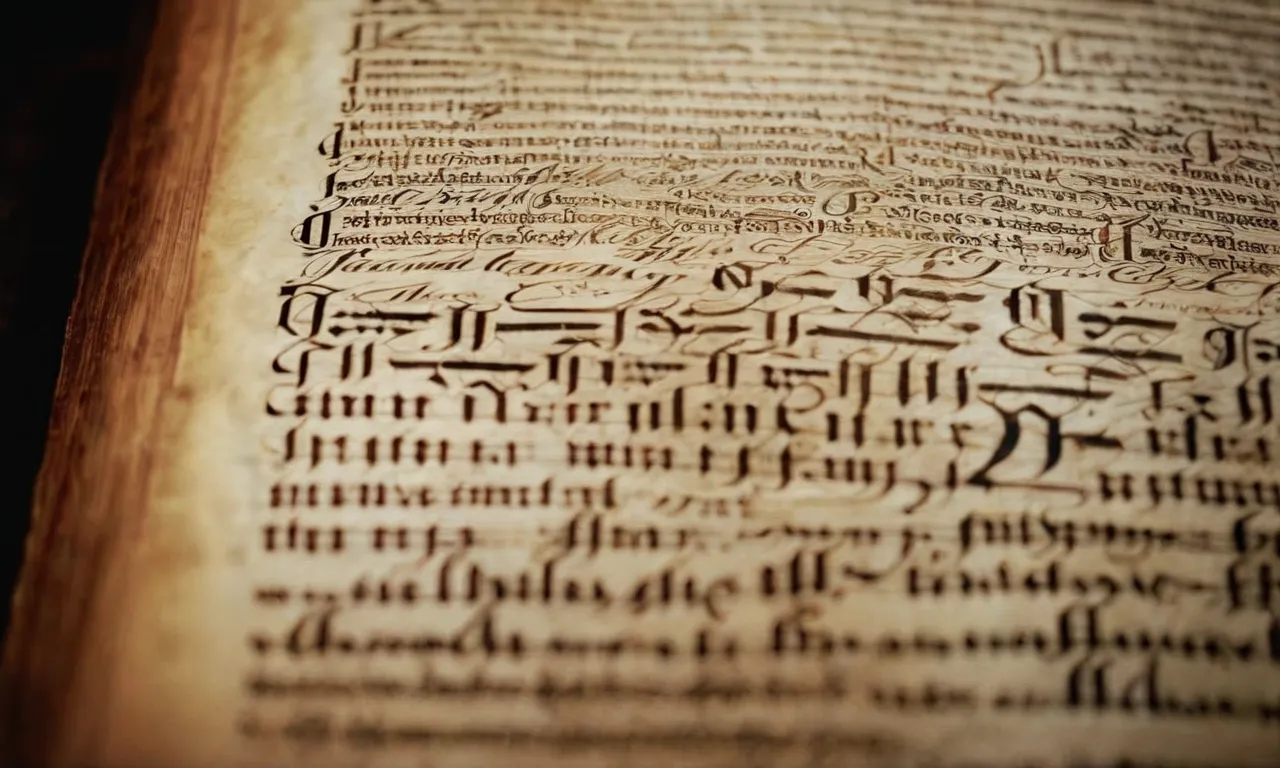Who Translated The Bible Into Latin
The history of Bible translations is long and winding, full of scholars, monks, and religious figures who sought to make the word of God accessible to people across languages and cultures. One pivotal translation that had an immense influence on Christianity in the West was the Latin Vulgate Bible, originally translated in the late 4th century AD.
If you’re short on time, here’s a quick answer: the Latin Vulgate Bible was translated by St. Jerome around the year 405 AD under commission by Pope Damasus I.
St. Jerome and His Commission to Translate the Bible
Jerome’s Background as a Scholar and Priest
St. Jerome (c. 342-420 AD) was one of the most learned scholars of his time. He originally pursued classical studies at schools in Rome before being baptized as a Christian in his 20s and soon after devoted himself to Biblical studies.
As a priest, he became known for his talent with languages, translating works of Greek philosophers and theologians into Latin. During this period, Jerome lived an ascetic lifestyle, pursuing wisdom, spiritual growth, and self-discipline.
Jerome was well-acquainted with the Hebrew and Greek Biblical texts, and would later make the Greek Hexapla, an early critical edition of the Greek texts showing their variations, his lifelong companion.
His extensive knowledge of languages, Biblical scholarship, and ascetic dedication made him an ideal candidate to produce an authoritative Latin translation of the Bible for the Western Church.
Pope Damasus’s Desire for a Standard Latin Translation
In 382 AD, Pope Damasus I commissioned Jerome to produce a definitive Latin version of the Bible for use across the Western Church. Up until that point, various Old Latin translations were used, but they contained differences in wording and accuracy.
Damasus recognized the importance of having a standard translation in the language that most Western Christians spoke: Latin.
Given Jerome’s knowledge, scholarly methodology, and familiarity with the original languages, Pope Damasus saw him as the right man for this crucial undertaking. Damasus helped facilitate Jerome’s relocation from Rome to Bethlehem, close to the Holy Land, so he could focus on the translation work with access to original texts and scholarly support.
Jerome’s Initial Work Translating from the Greek Texts
Jerome began by revising the existing Old Latin translations of the Gospels before tackling translating the remaining books of the New Testament directly from the best available Greek copies. He focused intensely on textual accuracy, word choice, and style, taking about a year to complete a draft translation of the New Testament.
Jerome then turned to producing new Latin translations from Hebrew texts for books of the Old Testament.
By 390 AD, Jerome had translated much of the Old Testament from the original Hebrew. He continued his translation work for the rest of his life, constantly revising and improving the Latin versions, even translating some books of the Apocrypha which were then in use by certain Greek Christians.
The result was the monumental work now known as the Latin Vulgate Bible, considered authoritative by the Catholic Church for over 1,500 years.
References
“DAMIEN‑PIERRON‑496‑046‑VULGATE‑CB653‑BBG‑108.pdf.” Cambridge University Press. Accessed Jan. 13, 2023.
Skeen, William, and Arthur Jeffery. “Jerome, St.” Encyclopædia Iranica, Dec. 15, 1999. Accessed Jan. 13, 2023.
The Process and Methods Jerome Used for His Translation
Consulting the Original Hebrew Manuscripts
When Jerome began his Latin translation of the Bible in 382 AD, one of his key goals was to consult the earliest Hebrew manuscripts rather than existing Greek or Latin versions. Jerome was fluent in Hebrew, allowing him to carefully analyze the original meaning and context of the Old Testament scriptures.
He worked to translate passages directly from Hebrew rather than simply revising existing Latin translations like the Vetus Latina (“Old Latin”) Bible used by the church at the time.
Jerome used manuscripts borrowed from synagogues and Jewish scholars to aid his translation process. He also studied Hebrew vocabulary, grammar, and style to produce an accurate translation. This represented a major shift from existing dynamic translation approaches that focused more on conveying overall meaning.
Jerome’s translation, known as the Vulgate, is still considered one of history’s most influential biblical translations thanks to his dedication to understanding the words and nuances of the earliest Hebrew biblical texts.
Goals of Providing an Accessible Translation
A major goal for Jerome in creating the Vulgate was to make the Bible more accessible for the common people of Europe. Up until this point, existing Latin bibles used complex, academic language that ordinary Christians would struggle to comprehend.
Jerome focused his translation on using clean, easy-to-understand Latin phrasing and grammar. He occasionally used the colloquial Latin common in everyday use to clarify passages. At times, Jerome even appears to directly transliterate idiomatic Hebrew expressions into Latin to convey the original meaning.
Some scholars challenged Jerome for dumbing down ecclesiastical language into a more populist form. But for Jerome, translating the “Word of God” required prioritizing the audience understanding Scripture itself over scholarly precision.
| Vetus Latina Bible | Complex vocabulary and grammar |
| Jerome’s Vulgate | Clear, concise phrasing for layaudience |
This drive towards accessibility aligned with Jerome’s ascetic values renouncing academic hubris; he sought to offer the Bible to Christian congregations and readers in an easy-to-comprehend form. Over 1,000 years later, the Catholic Church affirmed the success of Jerome’s mission at the Council of Trent by upholding the Vulgate as its official Latin translation.
Pope Damasus’s Funding and Support for Jerome’s Work
Jerome’s translation of the Bible into Latin relied heavily on the backing of Pope Damasus I. As the leader of Western Christianity, Damasus granted Jerome freedom from other clerical duties and funded his travel between Rome, Constantinople, and the Holy Land to access Hebrew manuscripts.
Scholars believe Pope Damasus directly commissioned Jerome to produce a major revision of existing Latin bibles to address errors and discrepancies. Jerome even refers to Damasus as urging him to take great care in “setting the seal upon the work” in a later preface outlining his translation methodology.
Some historians argue political calculations likely factored into Damasus’s patronage, seeing value in sponsoring such a definitive biblical translation under his leadership. Regardless, Damasus’s commission set the course for Jerome to spend his final 34 years spearheading the Vulgate project.
Damasus died in 384 AD, only two years into Jerome’s efforts, but left a lasting mark through bringing Jerome’s skills to bear on a momentous translation initiative that shaped Christian history. Jerome dedicated his resulting translation to Damasus, recognizing the key sponsorship role the Pope played in what he called “this perilous work.”
The Cultural Impact and Enduring Legacy of the Latin Vulgate
Use and Spread of the Vulgate Among Christian Communities
The Latin Vulgate Bible became the dominant version of the scriptures used in Western Christianity for over 1,000 years. Its widespread dissemination helped to standardize religious practices and theology across Europe and beyond.
The Vulgate was embraced by the clergy and laity alike, being utilized in monasteries, churches, schools and private households.
Some key factors that contributed to the Vulgate’s popularity and longevity include:
- It was the first full Latin translation of the Bible which helped replace the Old Latin translations used in various regions.
- Its translation style made the Bible more accessible to ordinary Christians compared to the original Greek and Hebrew.
- It was championed by influential figures like St. Augustine and given official sanction by Church authorities.
- The Vulgate was disseminated through the network of churches and monasteries, aided by the spread of printing in the 15th century.
By the 8th century AD, the Vulgate had almost fully supplanted the Old Latin texts. While vernacular translations emerged in the Middle Ages, the Vulgate remained the authoritative source until the Protestant Reformation in the 16th century.
Influence on Theology, Art and Literature in the Middle Ages
As the primary scriptural text used in the Middle Ages, the Vulgate left an indelible mark on medieval Christianity. Its Latin provided a common religious vocabulary that shaped theological thought and debate during this period.
Key theological concepts and doctrines that developed in the Middle Ages, like purgatory and transubstantiation, relied heavily on the Vulgate text.
The Vulgate also inspired some of the greatest works of medieval European art and literature. Scenes and characters from the Bible were favorite subjects of artists, vividly brought to life in paintings, sculptures, stained glass windows, illuminated manuscripts and carved portals and capitals on cathedrals.
Writers and poets drew inspiration from the lyrical Latin of the Vulgate, evident in literary masterpieces like Dante’s Divine Comedy.
Even after the Middle Ages ended, the style and phrasing of the Vulgate continued to influence religious art and literature for centuries. It left a rich legacy still visible today in the remaining artifacts and great works produced at the height of medieval Christendom.
Preserving the Vulgate Text and Translations Derived From It
Though challenged by humanist scholars and Protestant reformers, the Vulgate endured as the Catholic Church’s authorized Bible text. A series of critical editions were commissioned to standardize and preserve St. Jerome’s original Latin text.
The most definitive critical edition to date is the Stuttgart Vulgate published in 1969. This standardized reference text ensured that the Vulgate remained a living scriptural resource.
The Vulgate also served as the basis for many translations into European vernacular languages, like English, French, Spanish and German. Key examples include:
- John Wycliffe’s 14th century English translation, the first complete Bible in English.
- Martin Luther’s landmark German translation which helped spur the Protestant Reformation.
- The Douay-Rheims Bible (1582-1610) which became the standard Catholic English translation for centuries.
While no longer the sole Bible version used by Catholics, the Vulgate as a textual foundation continues to shape many modern translations. Its enduring legacy is its role in transmitting the scriptures across linguistic and cultural barriers over the past 1,500 years.
Conclusion
St. Jerome’s Latin translation of the Bible stands as one of the most influential works ever undertaken. Over 1,000 years after its initial translation, the Vulgate formed the backbone of Christianity across Europe.
It democratized access to the Bible for ordinary people in a way never seen before, while also standing the test of time as a remarkably accurate translation from the original ancient languages.
So next time you pick up a Bible, remember that you owe thanks in part to the diligent efforts of that erudite, hot-tempered scholar named Jerome, who saw the clear need for the word of God to be given new voice in Latin.








